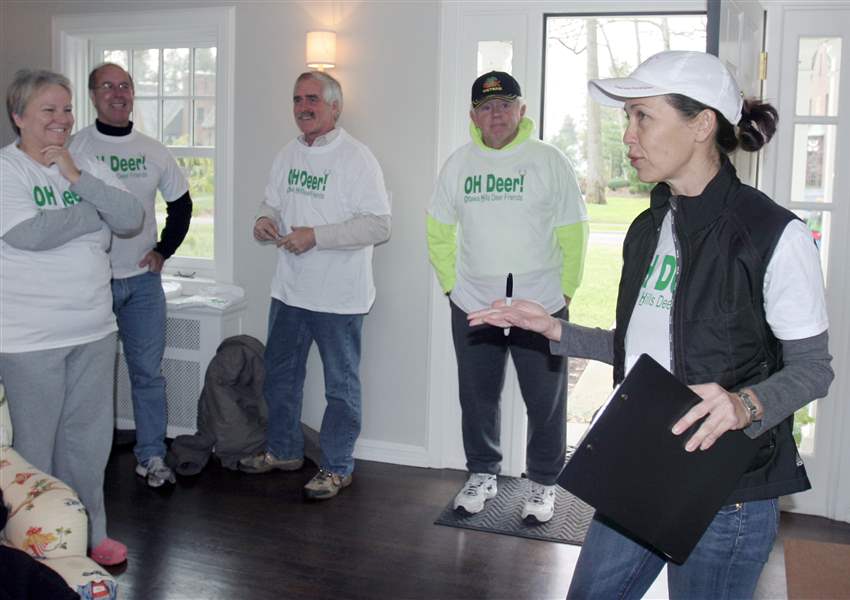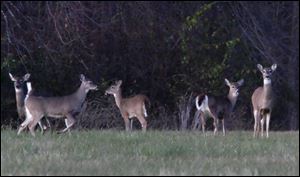
Vote on deer cull expected Monday night
11/23/2009
Margaret Rodriguez, right, talks to other opponents of the deer cull, all wearing their opposition T-shirts. From left are Cathy Appleby, Michael Eisenstodt, Jim Jenkins, and Clyde Appleby. Retired Ohio Supreme Court Justice Alice Robie Resnick shows deer repellents she uses in her yard in Ottawa Hills. She opposes the village proposal to hire a firm to kill up to 50 deer.
The Blade/Lisa Dutton
Buy This Image

Margaret Rodriguez, right, talks to other opponents of the deer cull, all wearing their opposition T-shirts. From left are Cathy Appleby, Michael Eisenstodt, Jim Jenkins, and Clyde Appleby. Retired Ohio Supreme Court Justice Alice Robie Resnick shows deer repellents she uses in her yard in Ottawa Hills. She opposes the village proposal to hire a firm to kill up to 50 deer.
Ottawa Hills Village Council is to decide Monday night whether the village should host the Toledo-area's first organized killing of deer in more than a decade.
Council is to decide whether to exempt an ordinance that has banned firearms from being discharged in the village since 1940. The vote is expected after the third and final reading of the proposed exemption.
Passing the exemption would allow the village to hire an outside firm to selectively kill up to 50 deer, a measure council's services and environment committee has proposed.
"All this does is give us the right to move forward and allow this to occur," Ottawa Hills Councilman Jim Walter, the committee's chairman, told The Blade earlier this month.
It would be the region's first selective kill, or cull, of deer since Perrysburg tried an experimental, controlled hunt in 1998 that became something of a public-relations nightmare. Perrysburg fell short of its goal of six deer when the hunt was called off after two does were taken.

Deer congregate at Dorr Street and Richards Road near Ottawa Hills.
Officials are simply responding to complaints by village residents who claim deer are damaging their property, Mr. Walter said.
They also assert that deer are so abundant in the village that they have become traffic hazards, he said.
Mr. Walter said the council would prefer to hire an outside firm if it goes through with the cull, to avoid liability and a public relations backlash against the village if something goes wrong.
The meeting is at 7:30 p.m., in the gymnasium of Ottawa Hills Elementary School, 3602 Indian Rd. Dozens of people are expected to attend.
Opponents claim the deer problem has been exaggerated and that the kill would be a waste of tax dollars.
The only firm known to travel the country for such culls, Connecticut-based White Buffalo Inc., has estimated the cost of the Ottawa Hills operation at $25,000 to $30,000 a year.
White Buffalo's co-founder and president, Anthony DeNicola, has said culling needs to be done over several years to be effective.
He said he is not interested in negotiating with any community that just wants a one-time cull.
Ottawa Hills Village Manager Marc Thompson has said the village probably would negotiate a two-year contract. But he said it would want an option to get out of the second year of any such agreement in the event the first year doesn't go as expected.
The village is eyeing the February-March period.
Meat from any cull would be salvaged for food pantries by an outreach ministry known as Farmers and Hunters Feeding the Hungry, Mr. Thompson said.
Although councilmen claim they have worked on the proposed exemption for almost three years now, a number of citizens opposed to the cull said the issue took them by surprise when they first heard about it last summer.
"I'm a little late coming to the party, but I didn't know there was a party," said Michael Eisenstodt, an Ottawa Hills resident who has served as a co-leader of the opposition movement.
Mr. Eisenstodt said he believes officials haven't done enough research into the village's deer population and its movement patterns, an accusation that officials deny.
Although officials estimate Ottawa Hills' current herd at 104 deer, it is unknown how many travel between the village and other large properties, such as Wildwood Metropark north of Central Avenue.
Records show most of the village's vehicle-deer collisions occur just south of Central.
Mr. Eisenstodt said he found it puzzling that village officials have been unable to quantify the damage to private property if deer have really caused that much destruction. Village officials don't have a cost estimate.
Some deer carry Lyme disease, but the Ohio Department of Health has said there is a low incidence of it in northwest Ohio. The Ohio Department of Natural Resources also considers the deer population in this part of the state to be stable and healthy.
"It would have made it easier [to accept a cull] if they could have made it a health and safety issue," Mr. Eisenstodt said.
He and retired Ohio Supreme Court Justice Alice Robie Resnick, another Ottawa Hills resident who opposes the cull, said the village first should consider more practical measures, such as encouraging residents having problems with deer to put up new fences or strengthen the fences they have.
Mr. Eisenstodt said that would "appease all those conservatives who fear big government and excessive government spending."
Ms. Resnick said that although the occasional deer has jumped her split-rail fence and nibbled her plants, she fails to understand why residents can't adapt to deer tastes and switch to plants the animals don't eat - or take greater precautions.
"I love lilies and so do the deer," she mused as she strolled past her large backyard garden.
Rather than give up those particular flowers, Ms. Resnick has repaired her fence and protected her plants with a combination of chemical and natural deer repellents.
She said Irish Spring soap has proven an effective defense for the lilies, because deer don't like its scent.
"There are a few people here who are relying on the government rather than taking personal responsibility for their own property," Ms. Resnick said.
"I don't expect the government here in Ottawa Hills to take care of my private property."
In addition to posting yard signs, opponents have printed T-shirts to publicize tonight's vote.
Parents were encouraged to have their children wear them to school on Monday, according to resident Margaret Rodriguez.
The village Web site, ottawahills.org, has information posted about the deer controversy.
Information compiled by opponents can be found online at villagedeer.com.
An online petition that opponents have generated can be accessed off the Web site or by going to http://sites.google.com/site/villagedeer/petition.
It had more than 300 entries last night.
Contact Tom Henry at:
thenry@theblade.com
or 419-724-6079.